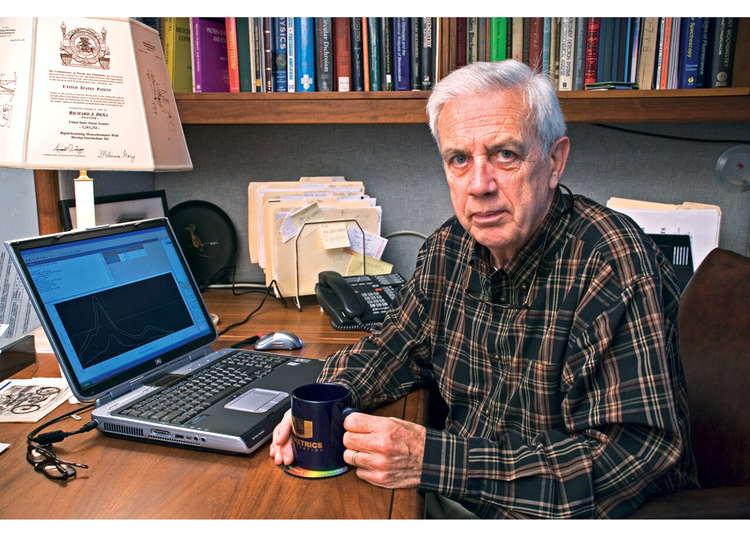How Circular Dichroism can Save You Time, Stress, and Money.
How Circular Dichroism can Save You Time, Stress, and Money.
Blog Article
The Circularly Polarized Luminescence Diaries
Table of ContentsAn Unbiased View of Circular DichroismSome Known Factual Statements About Uv/vis Getting My Spectrophotometers To WorkThe Buzz on Uv/vis/nirFascination About Circularly Polarized Luminescence

Although spectrophotometry is most commonly used to ultraviolet, visible, and infrared radiation, modern-day spectrophotometers can question broad swaths of the electromagnetic spectrum, including x-ray, ultraviolet, visible, infrared, and/or microwave wavelengths. Spectrophotometry is a tool that hinges on the quantitative analysis of particles depending upon just how much light is taken in by colored substances.
The Main Principles Of Uv/vis/nir
A spectrophotometer is frequently utilized for the measurement of transmittance or reflectance of options, transparent or nontransparent solids, such as refined glass, or gases. Although numerous biochemicals are colored, as in, they absorb visible light and for that reason can be determined by colorimetric treatments, even colorless biochemicals can frequently be converted to colored substances ideal for chromogenic color-forming responses to yield substances appropriate for colorimetric analysis.: 65 However, they can also be created to determine the diffusivity on any of the listed light ranges that generally cover around 2002500 nm using different controls and calibrations.
An example of an experiment in which spectrophotometry is utilized is the determination of the equilibrium constant of a service. A certain chemical response within a service may occur in a forward and reverse instructions, where reactants form products and items break down into reactants. At some time, this chemical reaction will reach a point of balance called a stability point.
Some Ideas on Circularly Polarized Luminescence You Should Know
The amount of light that goes through the option is a sign of the concentration of certain chemicals that do not enable light to pass through. The absorption of light is because of the interaction of light with the electronic and vibrational modes of molecules. Each type of molecule has a private set of energy levels related to the makeup of its chemical bonds and nuclei and therefore will soak up light of specific wavelengths, or energies, leading to special spectral homes.
They are commonly utilized in many industries consisting of semiconductors, laser and optical manufacturing, printing and forensic assessment, as well as in laboratories for the research study of chemical compounds. Spectrophotometry is often utilized in measurements of enzyme activities, decisions of protein concentrations, decisions of why not find out more enzymatic kinetic constants, and measurements of ligand binding reactions.: 65 Ultimately, a spectrophotometer is able to figure out, depending on the control or calibration, what substances are present in a target and exactly how much through computations of observed wavelengths.
Developed by Arnold O. Beckman in 1940 [], the spectrophotometer was created with the aid of his coworkers at his business National Technical Laboratories founded in 1935 which would end up being Beckman Instrument Business and eventually Beckman Coulter. This would come as a service to the previously created spectrophotometers which were unable to absorb the ultraviolet properly.
Circularly Polarized Luminescence for Dummies
It would be discovered that this did not offer satisfactory outcomes, for that reason in Model B, there was a shift from a glass to a quartz prism which enabled better absorbance results - UV/Vis/NIR (https://sketchfab.com/olisclarity1). From there, Model C was born with an adjustment to the wavelength resolution which ended up having three systems of it produced
It was produced from 1941 to 1976 where the price for it in 1941 was US$723 (far-UV devices were a choice at additional cost). In the words of Nobel chemistry laureate Bruce Merrifield, it was "most likely the most essential instrument ever developed towards the advancement of bioscience." Once it ended up being discontinued in 1976, Hewlett-Packard developed the first commercially available diode-array spectrophotometer in 1979 referred to as the HP 8450A. It irradiates the sample with polychromatic light which the sample takes in depending upon its properties. It is transmitted back by grating the photodiode variety which spots the wavelength region of the spectrum. Ever since, the production and execution of spectrophotometry gadgets has actually increased tremendously and has actually become one of the most innovative instruments of our time.

The Best Strategy To Use For Spectrophotometers
Historically, spectrophotometers utilize a monochromator containing a diffraction grating to produce the analytical spectrum. The grating can either be movable or repaired. If a single detector, such as a photomultiplier tube or photodiode is used, the grating can be scanned step-by-step (scanning spectrophotometer) so that the detector can determine the light strength at each wavelength (which will represent each "step").
In such systems, the grating is repaired and the strength of each wavelength of light is measured by a various detector in the variety. Additionally, most modern mid-infrared spectrophotometers use a Fourier change strategy to acquire the spectral details - https://urlscan.io/result/3823bc3a-74b6-4d0f-8f09-522e983b4d26/. This strategy is called Fourier transform infrared spectroscopy. When making transmission measurements, the spectrophotometer quantitatively compares the portion of light that goes through a referral solution and a test service, then digitally compares the strengths of the two signals and computes the portion of transmission of the sample compared to the referral requirement.

Report this page